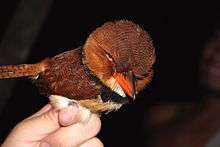Collared puffbird
| Collared puffbird | |
|---|---|
 | |
| Scientific classification | |
| Kingdom: | Animalia |
| Phylum: | Chordata |
| Class: | Aves |
| Order: | Piciformes |
| Family: | Bucconidae |
| Genus: | Bucco |
| Species: | B. capensis |
| Binomial name | |
| Bucco capensis Linnaeus, 1766 | |
The collared puffbird (Bucco capensis) is bird in the family Bucconidae that is found across the northern region of South America in the Amazon Basin, southern Colombia and Venezuela, and the Guianas.
In 1760 the French zoologist Mathurin Jacques Brisson included a description of the collared puffbird in his Ornithologie that was based on a specimen collected in French Guiana. He used the French name Le barbu and the Latin name Bucco.[2] Although Brisson coined Latin names, these do not conform to the binomial system and are not recognised by the International Commission on Zoological Nomenclature.[3] When in 1766 the Swedish naturalist Carl Linnaeus updated his Systema Naturae for the twelfth edition he added 240 species that had been previously described by Brisson.[3] One of these was the collared puffbird. Linnaeus included a terse description, coined the binomial name Bucco capensis and cited Brisson's work.[4] The specific name capensis denotes the Cape of Good Hope where Linnaeus mistakenly believed the birds occurred.[5]
The puffbirds are an insectivorous bird family, related to the jacamars but lacking the iridescent colours of that group. The collared puffbird grows to about 21 cm (8.3 in) in length, and prefers to sit and wait for prey, which has earned it nicknames such as "lazy bird" and "sleeper".
References
- ↑ BirdLife International (2012). "Bucco capensis". IUCN Red List of Threatened Species. Version 2013.2. International Union for Conservation of Nature. Retrieved 26 November 2013.
- ↑ Brisson, Mathurin Jacques (1760). Ornithologie, ou, Méthode contenant la division des oiseaux en ordres, sections, genres, especes & leurs variétés (in French and Latin). Volume 4. Paris: Jean-Baptiste Bauche. pp. 92–94, Plate 6 fig 2. The two stars (**) at the start of the paragraph indicates that Brisson based his description on the examination of a specimen.
- 1 2 Allen, J.A. (1910). "Collation of Brisson's genera of birds with those of Linnaeus". Bulletin of the American Museum of Natural History. 28: 317–335.
- ↑ Linnaeus, Carl (1766). Systema naturae : per regna tria natura, secundum classes, ordines, genera, species, cum characteribus, differentiis, synonymis, locis (in Latin). Volume 1, Part 1 (12th ed.). Holmiae (Stockholm): Laurentii Salvii. p. 168.
- ↑ Jobling, J.A. (2018). del Hoyo, J.; Elliott, A.; Sargatal, J.; Christie, D.A.; de Juana, E., eds. "Key to Scientific Names in Ornithology". Handbook of the Birds of the World Alive. Lynx Edicions. Retrieved 2 April 2018.
- Animal, Smithsonian Institution, 2005
External links
- Stamps (for Ecuador, Paraguay, Suriname) with RangeMap
- Collared puffbird photo gallery VIREO Photo-High Res--(Close-up, Head and Collar)
